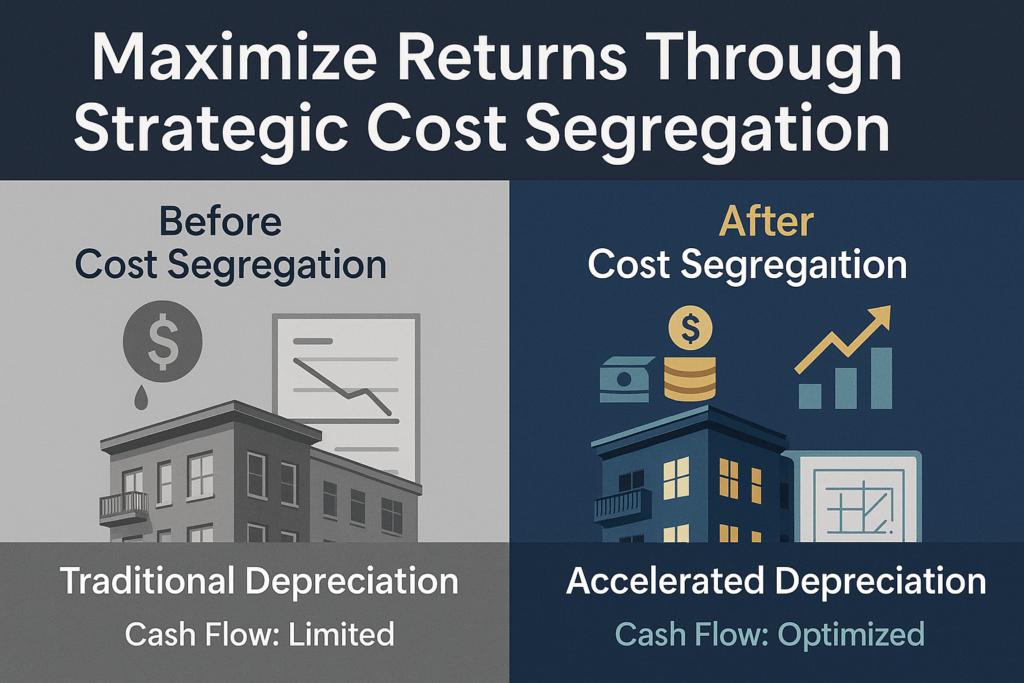Transform Your Multifamily Investment Performance Through Advanced Tax Strategy
If you’re serious about building wealth through multifamily real estate, you probably already know it takes more than collecting rent and hoping for appreciation. The most successful investors, the ones truly scaling their portfolios and unlocking massive gains are playing a different game. They’re combining operational excellence with smart, forward-thinking tax strategy.
And one of the most powerful but still underutilized tools at your disposal? Cost segregation.
This isn’t just a tax hack. It’s a wealth-building lever that can completely change the trajectory of your returns. In today’s market, where competition is fierce and margins are tight, the investors who win are the ones who know how to extract every bit of value from their assets—and their tax code.
Understanding Cost Segregation for Multifamily Properties
Cost segregation multifamily strategy involves a comprehensive engineering-based analysis that reclassifies building components to accelerate depreciation schedules. For properties with a basis of $750,000 or more, cost segregation provides optimal cost-benefit viability and can generate immediate tax savings that transform your investment returns.

Instead of depreciating your entire multifamily property over the standard 27.5-year residential schedule, cost segregation identifies components that qualify for much shorter depreciation periods.
Asset Classification Under Cost Segregation
Professional cost segregation studies categorize property components into specific depreciation schedules:
- 5-year property: Fixtures and appliances
- 7-year property: Office furniture and equipment
- 15-year property: Site improvements including parking areas and landscaping
For a typical $2 million multifamily acquisition, studies commonly identify 25-40% of the property’s value as shorter-life assets, creating substantial upfront depreciation benefits.
Maximizing Tax Advantages Through Strategic Implementation
Accelerated Depreciation and Bonus Benefits
Let’s talk timelines. Bonus depreciation has been COMPLETELY CHANGED—so timing is everything:
NEW RULES (effective January 19, 2025):
- 100% bonus depreciation is NOW PERMANENT for qualifying property acquired and placed in service after January 19, 2025
- No more phase-out schedule—full deduction available indefinitely
OLD RULES (still apply to property acquired before January 19, 2025):
- 80% in 2023
- 60% in 2024
- 40% in 2025
- 20% in 2026
- Gone by 2027
Key Points:
- Not retroactive: The new 100% rate only applies to property acquired AFTER January 19, 2025
- Transitional option: For assets acquired before January 19, 2025, but placed in service after that date, you can elect to use the previous rates
- New bonus: Qualified production property (nonresidential real estate for manufacturing/production) also gets 100% depreciation if construction starts after January 19, 2025
Important caveat: Residential rental properties still don’t automatically qualify unless certain improvements are made. Plus, Section 179 expensing limits increased to $2.5 million (with phase-outs at $4 million) for property placed in service after December 31, 2024.
Strategic 1031 Exchange Integration
Multifamily investors can defer capital gains taxes through strategic 1031 exchanges involving like-kind real property. Replacement property must be identified within 45 days and acquired within 180 days of sale. When combined with cost segregation benefits, this creates a powerful wealth accumulation engine.
Real Estate Professional Tax Benefits
Real estate professionals who meet the Material Participation and 750-hour annual tests can use multifamily depreciation to offset active income. Other investors can carry forward losses to offset future passive income or capital gains upon disposition.
Implementation Strategy: Your Step-by-Step Approach
Optimal Timing for Cost Segregation Studies
The best time to implement a cost segregation study is immediately following property acquisition. This timing maximizes depreciation benefits starting from the first year of ownership.
Catch-Up Studies for Existing Properties
For properties acquired in previous years, catch-up studies are still available. These allow owners to retroactively claim missed depreciation deductions without having performed the study initially.
Procedures for Catch-Up Studies
To file a catch-up study, follow these steps:
- Prepare a detailed fixed-asset inventory to document and classify all assets eligible for accelerated depreciation.
- File a Section 481(a) adjustment statement to reconcile the cumulative change in depreciation.
- Submit Form 3115 (Application for Change in Accounting Method) by the original due date of the tax return (including extensions) for the year the adjustment is taken.
Following these steps ensures compliance with tax regulations and enables owners to properly reflect depreciation adjustments from prior years. This process allows you to claim missed depreciation from prior ownership years.
Professional Team Selection
Engage engineering-based cost segregation firms that provide IRS-compliant studies. Quality studies typically cost $5,000 to $25,000 depending on property size and complexity but generate tax savings of 5-10 times the study cost.
Integration with Overall Investment Strategy
Coordinate cost segregation implementation with your broader portfolio strategy, considering depreciation recapture timing, future dispositions, and long-term wealth-building objectives.
Real-World Performance Impact
Let’s bring this home with a real scenario:
- 75-unit multifamily acquisition
- Purchase price: $4.2 million
1. Basis Allocation
- Purchase price: $4,200,000
- Building allocation (80%): $4,200,000 × 80% = $3,360,000
- Land allocation (20%): $840,000 (non-depreciable)
2. Traditional Straight-Line Depreciation
- Residential rental property depreciates over 27.5 years.
- Annual depreciation = $3,360,000 ÷ 27.5 = $122,182
- Tax savings at 24% bracket = $122,182 × 24% = $29,323
3. With Cost Segregation (Accelerated Depreciation)
- Assume year-one accelerated depreciation (bonus depreciation on short-life property): $625,000 (≈19% of depreciable basis — very realistic for multifamily)
4. Net First-Year Benefit
- Incremental benefit = $150,000 − $29,323 = $120,677
Summary (80% allocation)
- Straight-line depreciation: $122K annually → ~$29.3K tax savings
- Cost segregation year one: $625K accelerated → $150K tax savings
- Net first-year benefit = $120.7K
That’s capital you can use to pay down debt, renovate units, or jump on the next deal.
Advanced Strategies for Sophisticated Investors
Opportunity Zone Considerations
Investors in Opportunity Zone funds can benefit from cost segregation acceleration while pursuing long-term capital gains exclusions. Important consideration: Accelerated depreciation deductions reduce eligible basis for Opportunity Zone deferral and exclusion, creating a trade-off that requires careful analysis.

Strategic Disposition Planning
Understanding depreciation recapture rules allows sophisticated investors to time property sales strategically. Depreciation recapture is typically taxed at a 25% rate, and savvy investors can mitigate this through installment sales, charitable remainder trusts, or converting ordinary income depreciation into capital gains treatment.
Value-Add Integration
Coordinate cost segregation with value-add improvement strategies. Major renovations and capital improvements can trigger additional cost segregation opportunities, maximizing tax benefits throughout the ownership period.
Risk Management and Compliance
Make sure you:
- Get thorough engineering reports
- Include photos and clear documentation
- Stay audit-ready
Also, track your assets closely. If you replace or dispose of segregated items, your records should reflect it. Your team—CPA, attorney, cost segregation specialist—must stay aligned.
The Competitive Advantage of Tax Optimization
Successful multifamily investors recognize that real estate tax strategy extends far beyond basic depreciation. The most profitable operators combine cost segregation with:
- Strategic market selection and acquisition timing
- Value-add improvements that qualify for additional depreciation benefits
- Sophisticated financing structures that optimize after-tax cash flow
- Professional property management that maximizes operational efficiency
This integrated approach creates compounding returns that separate exceptional operators from average investors in competitive markets.

Implementation Action Plan
Cost segregation isn’t merely an accounting exercise—it’s a wealth acceleration strategy that can fundamentally transform your multifamily investment performance. The combination of immediate tax savings, enhanced cash flow, and reinvestment opportunities creates a powerful growth engine for serious investors.
Immediate Next Steps
- Portfolio Analysis: Review your current multifamily holdings for cost segregation opportunities, prioritizing properties with basis exceeding $750,000
- Professional Engagement: Connect with qualified cost segregation specialists who understand multifamily-specific considerations and IRS compliance requirements
Long-Term Wealth Building
Whether this is your first multifamily deal or your tenth, cost segregation should be on your radar. The tax savings can unlock capital to grow, upgrade, or scale—whatever your goals may be.
The truth is, the best investors aren’t just good at buying properties. They’re exceptional at maximizing every aspect of ownership. Cost segregation is one of the clearest, fastest ways to do just that.
Ready to unlock hidden value in your multifamily investments?
Start by connecting with qualified cost segregation professionals and give your portfolio the strategic tax edge it deserves.
Because in this business, every dollar you save is a dollar you can reinvest—and every smart move compounds over time.

